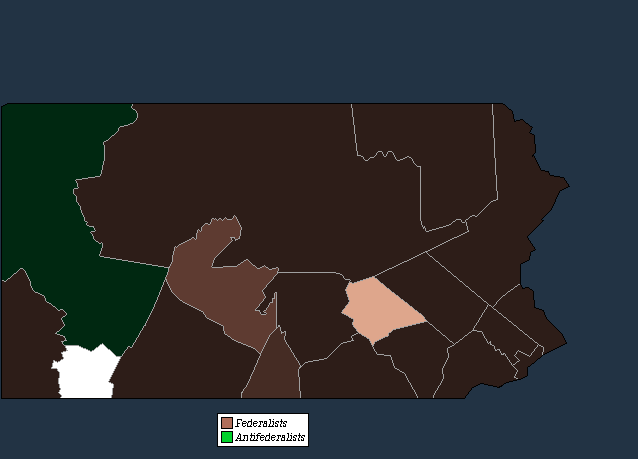American Psephology
The 1789 Presidential Election in Pennsylvania
On January 7, 1789, Pennsylvania's voters voted for ten at-large electors. Two electoral slates ran.
The federalist ticket:
- Edward Hand - 6711 votes
- Collinson Read - 6329 votes
- Laurence Keene - 6315 votes
- George Gibson - 6312 votes
- John Arndt - 6307 votes
- James Wilson - 6297 votes
- James O'Hara - 6279 votes
- David Grier - 6250 votes
- Samuel Potts - 6225 votes
- Alexander Graydon - 5954 votes
The antifederalist ticket:
- Edward Hand
- William Gibbons - 672 votes
- Thomas Craig - 487 votes
- David Rittenhouse - 424 votes
- James Potter - 421 votes
- John Smilie - 416 votes
- James MacLene - 413 votes
- Joseph Hiester - 402 votes
- Walter Stewart - 381 votes
- Philip Wager - 370 votes
A great deal of scattered candidates also received votes, with somewhere between eighty and ninety candidates getting a total of 644 votes.
A rough estimate of the average county returns are as follows. The vote was loose enough to where this can not be considered authoritative, but not loose enough to discount any sort of party polarization.

| Federalists | Antifederalists | |
| Bedford | 62 | 0 |
| Berks | 159 | 0 |
| Bucks | 443 | 0 |
| Chester | 491 | 9 |
| Cumberland | 160 | 0 |
| Dauphin | 196 | 173 |
| Fayette | ||
| Franklin | 301 | 82 |
| Huntingdon | 66 | 24 |
| Lancaster | 540 | 9 |
| Luzerne | 36 | 0 |
| Montgomery | 327 | 17 |
| Northampton | 312 | 12 |
| Northumberland | 157 | 0 |
| Philadelphia | 2176 | 14 |
| Washington | 21 | 0 |
| Westmoreland | 6 | 75 |
| York | 858 | 1 |
| Total | 6311 (93.82%) | 416 (6.18%) |
The federalist ticket was elected, and voted for Washington and Adams on February 4, with the exception of two, who voted for John Hancock.